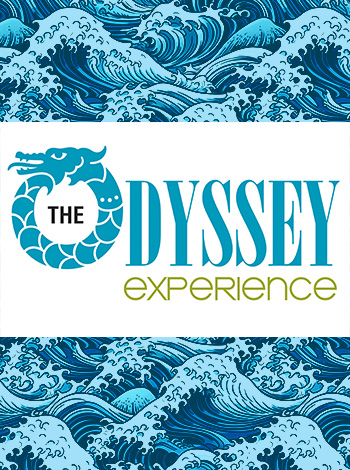Resource Guide - The Odyssey Experience
About the show
The audience becomes a part of the show in this epic adventure based on the Greek poem.Come on a wild adventure with the famed warrior Odysseus, king of Ithaca, in this completely interactive production! Adapted from the Greek poet Homer’s The Odyssey, this innovative experience welcomes you to be a part of the play as you are transported back to the time of the Trojan War. This participatory style of theatrical storytelling, experiential theater, will take you on a journey unlike any you’ve ever traveled before.For a full summary of the story click HERE.
THEMES: COURAGE, LOYALTY, ADVENTURE, WESTERN CULTURE
Audience expectations
Ensure that students understand correct audience behavior. It is appropriate to laugh and applaud, but not to talk during a performance unless prompted by the actors. Also try to encourage them to wait until the end of the performance to get up from their seats, except in cases of emergency.Whether viewing this performance as an assembly at your school, or at The Children’s Theatre of Charlotte on a field trip, the audience is a PART OF THE SHOW! The actors will encourage your students to become a part of the action and play pivotal roles in the show itself! Although the students do not need to know the story to be a part of it, the more familiar the students are with the story of The Odyssey, the better. They should expect to sit on the floor around the playing area so they can quickly become a part of the action!
The performance will be approximately 45 minutes, but it will be followed by a talkback with the performers (except in cases where the time allotted for assembly does not warrant it).
PLEASE ENCOURAGE STUDENTS TO ASK QUESTIONS!
NCES-TheaArts.(K-5).TA.CU.2: Understand the traditions, roles, and conventions of theatre as an art form. NCES-TheaArts.3.TA.CU.2.1: Illustrate theatre etiquette appropriate to the performance situation.
The BIG questions about the show
- Where do we find examples of the themes listed below in the story?
- Homecoming - Odysseus returning to Ithaca after 20 years away.
- Brains vs. Brawn - Odysseus outsmarting the suitors, Polyphemus and The Sirens as well as his use of disguises and ability to lead his sailors.
- Avoiding Temptation - Odysseus vs. the Sirens, Circe and Calypso. Also, the sailors opening the bag of wind and Penelope’s refusal to choose a new husband.’
- Love Conquers All - Penelope and Odysseus are reunited. Odysseus’ ability to string the bow and shoot the 12 arrows through the axes as a sign he is Penelope’s true love.
- Man vs. Nature - Odysseus and his crew battling several storms, Scylla and Charybdis.
- Gaining Assistance from Immortals - Athena, Zeus, Aeolus & Circe help Odysseus throughout the story.
- What morals or lessons can we learn from the themes of Odysseus’ tale?
- Beware of strangers - The Lotus eaters are gentle and hospitable to Odysseus and his men, but the Lotus they offer them distracts the sailors from their goal of returning home.
- Greed - When the sailors are greedy on Aeaea, Circe turns them into pigs. When the sailors are greedy and open the bag of wind, thinking it is treasure, they are sent far off-course. The sailors are greedy and kill the cattle of the sun and are punished and killed by Zeus. The suitors are caught up in greedy pursuits back in Ithaca and are outsmarted and killed by Odysseus.
- Follow Instructions - Odysseus and his men are cursed with a storm by Zeus when they disobey him and eat the cattle of the Sun. Conversely, when Odysseus follows the instructions of Circe, the men survive The Sirens, Scylla and Charybdis.
- How does this story compare to other myths, religious stories or fables?
- Compare The Odyssey’s themes to stories from Modern Culture. Below are some examples, but feel free to add to the list!
- Homecoming - The Wizard of Oz, Homeward Bound, Bolt
- Brains vs. Brawn - Harry Potter, Spiderman
- Avoiding Temptation - Sleeping Beauty (spindle), The Jungle Book (Kaa)
- Love Conquers All - Snow White, Shrek
- Man vs. Nature - Castaway, Into the Wild, The Jungle Book
- Gaining Assistance from Immortal Beings - Aladdin, Cinderella
CCSS.ELA-Literacy.SL.(K-5).2: Ask and answer questions about key details in a text read aloud or information presented orally or through other media.
THE CHARACTERS
Click HERE for a list of the MORTALS, IMMORTALS, and BEASTS in the story!CCSS.ELA-Literacy.RL.4.3 Describe in depth a character, setting, or event in a story or drama, drawing on specific details in the text (e.g., a character's thoughts, words, or actions).
Activities
Cause & EffectClick HERE for Activity: Cause & Effect (includes Answer Key)
Common Core Standards for English Language Arts and Literacy: SL2: Ask and answer questions about key details in a text read aloud or information presented orally or through other media; RL7: Make connections between the text of a story or drama and a visual or oral presentation of the text. 5.RL.3 Compare and contrast two or more characters, settings, or events in a story or drama, drawing on specific details in the text (e.g., how characters interact). RL.3.3 Describe characters in a story (e.g., their traits, motivations, or feelings) and explain how their actions contribute to the sequence of events.
More Ideas for Theatre in the Classroom!
- The Interview: Have one student play the part of a character from The Odyssey or Greek Mythology. They should sit or stand in front of the classroom. Moderated by you, have the other students ask questions and interview this character while the student being interviewed responds as their character.
- Theatrical Adaptation: Take a well-known story or fairy tale and collaborate to act it out using resources available in the classroom. This can be done in small groups or all together. Think of things you can use as props such as erasers or book bags and rearrange classroom furniture to create a set!
- Critique & Revision: After completing either of the above exercises, allow students to give constructive criticism to each other. To avoid hurting others feelings, you may want to pose guided questions to them about the performance, such as “Could you hear the performer speaking? Did you believe their character? What is something that can add to this performance?” After the informal critiques, allow each student or group to take the constructive criticism and revise their performances.
- Explore Theatrical Design: Have students discuss or write out ideas for physical elements used to tell a story. Using a classic myth or fable, have them design the set including cultural elements, make a list of props, or draw some historical costumes.
Click HERE for a Zues themed maze and additional coloring pages.
Common Core Standards for English Language Arts and Literacy: RL7: Make connections between the text of a story or drama and a visual or oral presentation of the text. NCES.VisArts.2.V.3: Create art using a variety of tools, media, and processes, safely and appropriately.
Talk about jobs in the theatre
Every play Children’s Theatre of Charlotte produces is created by a talented team of designers, technicians, actors and a director. As a class, discuss what you experienced when you saw the performance.- Name three things you noticed about the set. Did the set help tell the story? What sort of set would you design?
- What did you like about the costumes? Did the costumes help tell the story? What sort of costumes would you design?
- Talk about the actors. Were there moments you were so caught up in the story you forgot you were watching a play?
- Were there any actors who played more than one character? What are some ways you can show you are a different character?
NCES-TheaArts.(K-5).TA.A.1: Analyze literary texts and performances. NCES-TheaArts.(K-5).TA.AE.1.2: Understand how costumes [and technical elements] enhance dramatic play.

Written and Directed by Christopher Parks




